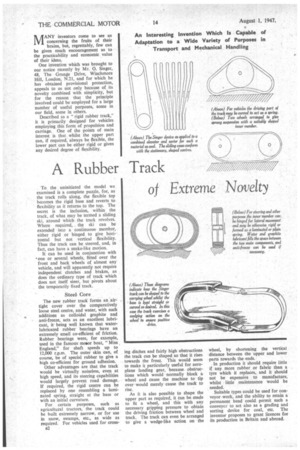A Rubber Track
Page 36

If you've noticed an error in this article please click here to report it so we can fix it.
of Extreme Novelty MANY inventors come to see us concerning the fruits of their brains, but, regrettably, few can be given much encouragement as to the practicability and economic value of their ideas.
One invention which was brought to our notice recently by Mr. 0. Singer, 48, The Grange Drive, Winchmore Hill, London, N.21, and for which he has obtained provisional protection, appeals to us not only because of its novelty combined with simplicity, but for the reason that the principle involved could be employed for a large number of useful purposes, some in our field, some in others.
Described as a "rigid rubber track," it is primarily designed for vehicles employing this form of propulsion and carriage. One of the points of main interest is that whilst the upper part can, if required, always be flexible, the lower part can be either rigid or given any desired degree of flexibility.
To the uninitiated the model we examined is a complete puzzle, for, as the track rolls along, the flexible top becomes the rigid base and reverts to flexibility as it returns to the top. The secret is the inclusion, within the track, of what may be termed a sliding ski, around which the track revolves. Where required, the ski can be extended into a continuousmember, either rigid or hinged to give horizontal but not vertical flexibility. Thus the track can be steered, and, in fact, can have a snake-like motion.
It can be used in conjunction with one or several wheels, fitted over the front and back wheels of almost any vehicle, and will apparently not require independent clutches and brakes, as does the ordinary type of track which does not itself steer, but pivots about the temporarily fixed track.
• Steel Core
The new rubber track forms an airtight cover over the comparatively loose steel centre, and water, with such additions as colloidal graphite and anti-freeze, acts as an excellent lubricant, it being well known that waterlubricated rubber bearings have an extremely small co-efficient of friction. Rubber bearings were, for example, used in the famous motor boat, "Miss England," for shaft speeds up to 12,000 r.p.m. The outer skin can, of course, be of special rubber to give a high co-efficient for ground adhesion.
Other advantages are that the track would be virtually noiseless, even at high speed, and its steering capabilities would largely prevent road damage. If required, the rigid centre can be replaced by one resembling a laminated spring, straight at the base or with an initial curvature.
For certain purposes, such as agricultural tractors, the track could be built extremely narrow, or for use in snow, swamps, etc., as wide as required. For vehicles used for cross a2 ing ditches and fairly high obstructions the track can be shaped so that it rises towards the front. This would seem to make it particularly useful for aeroplane landing gear, because obstructions which would normally block a wheel and cause the machine to tip over would merely cause the track to rise.
As it is also possible to Shape the upper part as required, it can be made to fit a wheel, and this with any necessary gripping pressure to obtain the driving friction between wheel and track. The track can even be arranged to give a wedge-like action on the wheel, by shortening the vertical distance between the upper and lower parts towards the ends.
In production it should require little if any more rubber or fabric than a tyre which it replaces, and it should not be expensive to manufacture, whilst little maintenance would be needed.
Suitable types could be used for conveyor work, and the ability to retain a permanent bend could permit such a conveyor to act also as a grading and sorting device for coal, etc. The inventor proposes to grant licences for its production in Britain and abroad.












































































